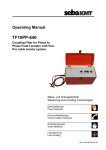Download 150R/150T Quick Start Guide
Transcript
150R/150T Quick Start Guide Getting to Know Your 150R/T/B Locating System 150R Controls Overview On-Off/Cancel: To turn on, press. To turn off, press again. To cancel current action in menu mode, press. Signal Strength Display: Signal strength is shown by bars at top of display and in numeric display. Up Arrow: To increase manual gain, press. To scroll up menu options in menu mode, press. Gain Display: Gain (amount of signal amplification) is shown by bars below signal strength indicator. Gain increases to the right and in numeric display at lower left. Menu/Select: To access the menu screen, press. To select highlighted menu option, press again. Down Arrow: To decrease manual gain, press. To scroll down menu options in menu mode, press. Receiver Battery Level Display: Three segments mean that batteries are at full level. One segment means that batteries are at low level. No segments means that you should change batteries soon. 150T Controls Overview Power: Position switch up for high power output, down for low power output and center for off. Green LED: Indicates sufficient battery level when solid. Light begins to flash when battery becomes low. If light flashes when unit is turned on, then batteries are low or one battery is installed backwards. Startup Tips Installing the Batteries Choosing Signal Type 150R 150T Use two C-cell alkaline batteries in receiver. Use six C-cell alkaline batteries in transmitter. To install To install 1. Remove battery cover. 1. Open battery cover. 2. Insert batteries as shown with positive (+) ends pointing toward the display end of the receiver. 3. Install and tighten battery cover. 4. Check operation. 2. Insert batteries as shown. Active: There are three ways to place active signals on a target line with a transmitter. Direct connection (preferred method) requires a connection to be made directly onto target line. Induction clamp requires placing a clamp around target line. Broadcast induction sends signal into all lines near the transmitter. Beacon: Beacon signals allow metallic and non metallic pipe tracing. IMPORTANT: Do not mix new and used batteries. 3. Close and tighten battery cover. Passive: Power utility lines can be located passively without a transmitter. Use 60P to locate utilities from main line to transformer and use 60S to locate utilities from transformer to meter. 4. Check operation. If green LED flashes upon startup, then battery installation is incorrect or batteries are weak. Antenna Configuration Frequency The receiver is factory configured in one of two antenna configurations: peak or null. However, peak units and null units have the ability to operate in either mode by rotating the receiver 90° in either direction. The 150R is factory configured in either peak or null mode. Units configured to operate in Peak mode will have one active frequency (640hz, 30kHz or 83kHz) as well as two passive power modes (60S and 60P). Units configured to operate in Null mode will have only one frequency (83kHz). • • Peak: Response is highest at strongest signal. When to use: in most applications. Null: Response is lowest when receiver is over the line or beacon. When to use: to verify location of target line after it has been located in peak antenna configuration. All 150R receiver units can locate in either peak or null mode. The 150T transmitter is designed to place signals on target lines and is configured in either 30kHz or 83kHz frequency. • Lower frequencies travel farther than higher frequencies. • Higher frequencies couple onto lines more easily. • Higher frequencies also couple onto lines other than the target line more easily. Rotate receiver 90° to locate using other antenna mode. When rotated 90°, a peak configured receiver will function as a null receiver or a null configured receiver will function as a peak. IMPORTANT: See Operator’s Manual for detailed safety and operating instructions. Laminated: P/N 790-1009 B 150R/150T Quick Start Guide Operating Your 150R and 150T Locating System Active Location - Direct Connect Active Location - Induction Clamp NOTICE: Turn off transmitter when connecting or moving ground stake. 1. Plug cable into transmitter (1). 2. Place clamp around line (2). 1. Drive ground stake (4). 3. Turn on transmitter. 2. Plug cable into transmitter (2). 4. Check battery level. 3. Hook black lead to ground stake (3). NOTICE: Do not unplug induction clamp from transmitter when connected to line. Removing cable will cause an arc and could damage equipment or cause injury. 4. Hook red lead to line (1). 5. Turn on transmitter. 6. Check battery level indicator. NOTICE: Do not unplug direct connect cable when connected to line. Removing cable will cause an arc and could damage equipment or cause injury. 7. Walk in an arc approximately 25’ (7.5 m) around transmitter. 5. Walk in an arc approximately 25’ (7.5 m) around transmitter. 6. Hold the receiver so that the handle points toward the transmitter, as shown. 7. Identify location of line by finding the spot with the best signal response. 8. Hold the receiver so that the handle points toward the transmitter, as shown. 9. Identify location of line by finding the spot with the best signal response. Active Location - Broadcast Passive Location Beacon Location 1. Remove cable, stake, clamp and any other metal objects from transmitter. 1. Turn on receiver. 1. Install beacon battery with positive end away from battery cap. 2. Place transmitter parallel to and directly above suspected line as shown. Note: Transmitter must be parallel to object, as shown, in order to produce the best signal. 3. Turn on transmitter. 4. Check battery level indicator. 5. Walk in an arc approximately 25’ (7.5 m) around transmitter. 6. Hold the receiver so that points toward the transmitter, as shown. 7. Identify location of line by finding the spot with the best signal response. 2. Select frequency and antenna configuration. 3. Make a visual check of the site for signs of buried lines such as: recent trenching, buried line markers, overhead lines that run down pole and underground, gas meters, valve sights, and drains or manhole covers. 4. Search the site by walking a grid pattern while holding receiver close to the ground. Keep the receiver horizontal. 5. Move the receiver over the detected signal to find the best signal response. If using a peak antenna mode, rotate the receiver until the signal is strongest. Strongest signal indicates line direction. 6. Walk along the suspected path while moving the receiver side to side. 2. Turn on receiver to ensure that beacon is functioning properly. 3. Attach beacon to plumber’s snake or flex rod. 4. Place beacon into pipe and move it down the pipe. 5. To locate beacon, circle over its approximate location in the pipe. 6. To identify beacon location find the spot with the strongest signal response. 7. Rotate the receiver to determine which direction the beacon runs. IMPORTANT: Receiver indicates the strongest signal when handle is perpendicular to the beacon. 8. Continue to track the beacon. Mark pipe location with paint. 7. Sweep, focus, and trace all detected signals in the area. Mark line paths with colored paint or flags. IMPORTANT: See Operator’s Manual for detailed safety and operating instructions. Laminated: P/N 790-1009 B












